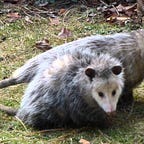Intrasexual Selection: Why Beetles Wrestle And Salamanders Race
This article is a sequel to Intersexual Selection & Why Animals Choose Colorful Mates, so please read that article first.
In September, on the coasts of the islands surrounding Antarctica, the usually barren beaches flood with the round, blubbery bodies of Southern Elephant Seals. Every year, these seals congregate among the rocks and beaches to breed and give birth. Yet, visiting the island a month prior would reveal an entirely different event. In late summer only male seals are present on the island. Elephant seals are sexually dimorphic, with males six times heavier than females. These massive seals, reaching weights of 8,800 pounds, fight each other while awaiting the arrival of the females. These fights establish a dominance hierarchy, with the winners claiming large harems of many dozens of females.
This combat ritual represents intrasexual selection, where animals adapt to better compete with rivals of the same sex for mates. Specifically, this is contest competition, where there is a definitive winner, who breeds, and a definitive loser, who does not. Due to Bateman’s principle, which suggests that the sex which must expend the most energy by reproducing becomes selective in their mate, intersexual selection mostly occurs between females. Since female seals have a gestation period of 11 months, and males’ commitment ends at breeding, the females decide which males are worth the effort.
But intrasexual selection, like the seals’ combat, allows males to minimize their competition for females before they even see their options. As a result, only the best fighters breed. Larger males win fights, so genes which promote increased size pass on and reinforce the size-based sexual dimorphism.
Contest competition not only selects for larger males but better-equipped ones. Many distantly related animals have developed weapons to fare better in combat. While the exact form of these weapons is quite diverse, they tend to manifest on or near the head. Stag beetles, for example, have massive mandibles which they use to grab and throw each other.
These weapons, while useful intrasexual competition, are different than the ornaments formed through runaway selection. Success in combat drives weapon evolution, not female preference. Males use their weapons to defend their territory from opposing males as well, meaning the trait is useful outside of intrasexual selection.
Aside from benefitting the dominant males, contest competition also ensures females of their mate’s fitness. In a mechanism similar to the sexy son hypothesis, victorious males will give their offspring genes associated with larger body and weapon size. The good gene hypothesis also appears relevant. With stag beetles, weapon size correlates to the beetle’s health. The size of stag beetles’ mandibles depends heavily upon their diet during youth. By selecting for larger mandibles, these beetles indirectly select for traits associated with nutritional success.
When there is a high population density of males, scramble competition occurs. In this system, the male who can reproduce with the female fastest, regardless of any dominance hierarchy, or desirability by the female, will succeed. This competition benefits smaller, less equipped males who often lose in contest competition. This happens in elephant seals, as the harems leave many males without mates. The losing seals may sneak into the more dominant bull’s territory and breed before they are caught.
Scramble competition also exists in species without combat competition. In red spotted newts, who have no dominance hierarchies, intrasexual selection favors males with larger, stronger tailfins, which help them reach females fastest. Once again, this tailfin also benefits the newt outside of reproduction, as it increases their mobility. This distinguishes such traits from the useless ornaments produced in interspecies selection.
Each form of intrasexual selection has a negative effect, however. Contest competition, often involving combat, poses a risk to males, as they often get seriously hurt. So each individual must weigh the risk and reward of an encounter. When a female is present, for example, males tend to fight more, as the risk is more likely to result in a direct reward of reproduction. Individuals may forfeit an encounter if the reward is too low, or the risk of losing too high.
An examination of Japanese rice fish revealed that scramble competition can have negative effects on the fitness of females. When there is a high density of male fish, some turn to strategies like sneak mating, where a male interrupts another reproducing and releases his own sperm, hoping to fertilize the unsuspecting female. This practice increases distress in the female, and reduces the chance of successful reproduction. This practice also removes the female’s autonomy to decide which mate is suitable, possibly reducing the success of her offspring.
Through both contest competition and scramble competition, males limit their competition before female input. These forms of selection often stack, resulting in species which are sexually dimorphic in color and size. As we understand intrasexual and intersexual selection individually, we must also consider how they interact with each other to change the trajectory of natural history.
